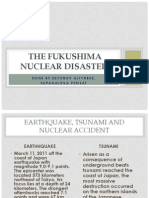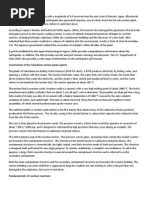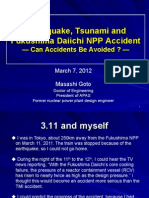0 ratings0% found this document useful (0 votes)
30 viewsArrival of Tsunami
The tsunami that hit the Fukushima Daiichi Nuclear Power Plant following the 2011 Tōhoku earthquake was 13-14 meters high, overwhelming the plant's 10 meter seawall. The waves flooded the basements of the turbine buildings around 15:41, disabling the emergency diesel generators and cutting power to the cooling systems. Batteries provided power for around 8 hours but failed when additional mobile generators arrived almost 6 hours after the tsunami. The loss of cooling systems to the reactor cores led to meltdowns in reactors 1, 2 and 3.
Uploaded by
Crisanto Coquia YcoCopyright
© © All Rights Reserved
We take content rights seriously. If you suspect this is your content, claim it here.
Available Formats
Download as DOCX, PDF, TXT or read online on Scribd
0 ratings0% found this document useful (0 votes)
30 viewsArrival of Tsunami
The tsunami that hit the Fukushima Daiichi Nuclear Power Plant following the 2011 Tōhoku earthquake was 13-14 meters high, overwhelming the plant's 10 meter seawall. The waves flooded the basements of the turbine buildings around 15:41, disabling the emergency diesel generators and cutting power to the cooling systems. Batteries provided power for around 8 hours but failed when additional mobile generators arrived almost 6 hours after the tsunami. The loss of cooling systems to the reactor cores led to meltdowns in reactors 1, 2 and 3.
Uploaded by
Crisanto Coquia YcoCopyright
© © All Rights Reserved
We take content rights seriously. If you suspect this is your content, claim it here.
Available Formats
Download as DOCX, PDF, TXT or read online on Scribd
You are on page 1/ 1
Arrival of tsunami[edit]
The height of the tsunami that struck the station approximately 50 minutes after the earthquake.
A: Power station buildings
B: Peak height of tsunami
C: Ground level of site
D: Average sea level
E: Seawall to block waves
The largest tsunami wave was 13–14 m (43–46 feet) high and hit approximately 50 minutes after the
initial earthquake, overwhelming the plant's seawall, which was 10 m (33 ft) high.[9] The moment of
impact was recorded by a camera. [34]
Disabling of emergency generators[edit]
The waves overtopped the plant's 5.7 m (19 ft) seawall,[35][36][37] flooding the basements of the power
plant's turbine buildings and disabling the emergency diesel generators [38][39][40] at approximately 15:41.
[32][41]
TEPCO then notified authorities of a "first-level emergency". [42] The switching stations that
provided power from the three backup generators located higher on the hillside failed when the
building that housed them flooded.[43] Power for the plant's control systems switched to batteries
designed to provide power for about eight hours. [44] Further batteries and mobile generators were
dispatched to the site, but were delayed by poor road conditions; the first arrived at 21:00 11 March,
[33][45]
almost six hours after the tsunami struck. The flooded diesel generators failed soon afterwards,
resulting in a loss of power to the critical coolant water pumps. These pumps were needed to
continuously circulate coolant water through the reactor cores for several days to keep the fuel
rods from overheating, as the rods continued to generate decay heat after fission had ceased. Core
cooling was now reliant on secondary emergency pumps run by back-up electrical batteries, but
these ran out of power on 12 March, one day after the tsunami. [46] The water pumps stopped and
the reactors began to overheat. The lack of cooling water eventually led to meltdowns in Reactors 1,
2, and 3.
Unsuccessful attempts were made to connect portable generating equipment to power water pumps.
The failure was attributed to flooding at the connection point in the Turbine Hall basement and the
absence of suitable cables.[39] TEPCO switched its efforts to installing new lines from the grid. [47] One
generator at unit 6 resumed operation on 17 March, while external power returned to units 5 and 6
only on 20 March.[48]
You might also like
- Fukushima Daiichi Nuclear Power Disaster Case75% (8)Fukushima Daiichi Nuclear Power Disaster Case11 pages
- Fukushima Daiichi Nuclear Disaster MARCH 11,2011No ratings yetFukushima Daiichi Nuclear Disaster MARCH 11,201122 pages
- Fukushima Nuclear Power Plant Risk Assessment100% (1)Fukushima Nuclear Power Plant Risk Assessment11 pages
- Friday, 11 March: 1446 Local Time (0546 GMT)No ratings yetFriday, 11 March: 1446 Local Time (0546 GMT)7 pages
- Anatomy of A (Par-Al) Meltdown: Fukushima Daiichi Nuclear Power PlantsNo ratings yetAnatomy of A (Par-Al) Meltdown: Fukushima Daiichi Nuclear Power Plants35 pages
- Assignment # 1 Japan Nuclear Explosion Safety Report: Submitted ToNo ratings yetAssignment # 1 Japan Nuclear Explosion Safety Report: Submitted To2 pages
- Information On Status of Nuclear Power Plants in Fukushima: Japan Atomic Industrial Forum, IncNo ratings yetInformation On Status of Nuclear Power Plants in Fukushima: Japan Atomic Industrial Forum, Inc6 pages
- Information On Status of Nuclear Power Plants in Fukushima: Japan Atomic Industrial Forum, IncNo ratings yetInformation On Status of Nuclear Power Plants in Fukushima: Japan Atomic Industrial Forum, Inc6 pages
- TEPCO's Nuclear Power Plantssuffered From Big Earthquake Ofmarch 11,2011No ratings yetTEPCO's Nuclear Power Plantssuffered From Big Earthquake Ofmarch 11,201122 pages
- FAQs About US Nuclear Power Plant Safety After Japan Nuclear Crisis - NRC - GovNo ratings yetFAQs About US Nuclear Power Plant Safety After Japan Nuclear Crisis - NRC - Gov9 pages
- March 11th 2011 1600 EST USNRC Emergency Operations Center Status UpdateNo ratings yetMarch 11th 2011 1600 EST USNRC Emergency Operations Center Status Update5 pages
- Reactor Status and Major Events Update 17 - NPPs in Fukushima As of 10:00 MarchNo ratings yetReactor Status and Major Events Update 17 - NPPs in Fukushima As of 10:00 March4 pages
- It All Started On Friday, 11 March 2011, 2.46 PMNo ratings yetIt All Started On Friday, 11 March 2011, 2.46 PM8 pages
- Nuclear Power in Japan: Fukushima and After: Richard TanterNo ratings yetNuclear Power in Japan: Fukushima and After: Richard Tanter89 pages
- Facts and Lessons of The Fukushima Nuclear Accident and Safety ImprovementNo ratings yetFacts and Lessons of The Fukushima Nuclear Accident and Safety Improvement80 pages
- Olatunde J Aladesote Ryan Carter, and Petronella James-OkekeNo ratings yetOlatunde J Aladesote Ryan Carter, and Petronella James-Okeke7 pages
- Water: An Earthquake Struck Off The Coast of JapanNo ratings yetWater: An Earthquake Struck Off The Coast of Japan4 pages
- Case Study on Fukushima EEE423 20121037No ratings yetCase Study on Fukushima EEE423 2012103710 pages
- Japan Earthquake - Friday 11 March Part One: Al-Jazeera Is Streaming Live Coverage of The Events in JapanNo ratings yetJapan Earthquake - Friday 11 March Part One: Al-Jazeera Is Streaming Live Coverage of The Events in Japan4 pages
- Earthquake, Tsunami and Fukushima Daiichi NPP Accident: - Can Accidents Be Avoided ?No ratings yetEarthquake, Tsunami and Fukushima Daiichi NPP Accident: - Can Accidents Be Avoided ?40 pages
- 18-03-11 Understanding Japan's Nuclear CrisisNo ratings yet18-03-11 Understanding Japan's Nuclear Crisis7 pages
- Image Recognition of Instrumentation Panels in A Nuclear Power PlantNo ratings yetImage Recognition of Instrumentation Panels in A Nuclear Power Plant5 pages
- Fukushima Crisis - Unmonitored Releases - Preliminary ASsessment of Accident Sequences and Potential Atmostpheric Radiation ReleasesNo ratings yetFukushima Crisis - Unmonitored Releases - Preliminary ASsessment of Accident Sequences and Potential Atmostpheric Radiation Releases29 pages
- Annex III of Technical Volume 2 Detailed Description of Relevant Operating ExperienceNo ratings yetAnnex III of Technical Volume 2 Detailed Description of Relevant Operating Experience5 pages
- Devastating Nuclear Accidents throughout History: Causes and Results - Science Book for Kids 9-12 | Children's Science & Nature BooksFrom EverandDevastating Nuclear Accidents throughout History: Causes and Results - Science Book for Kids 9-12 | Children's Science & Nature BooksNo ratings yet
- Interactive Table of Contents: Page NumberNo ratings yetInteractive Table of Contents: Page Number1 page
- Interactive Table of Contents: Page NumberNo ratings yetInteractive Table of Contents: Page Number1 page
- Domain 2: Linguistics of The Target LanguageNo ratings yetDomain 2: Linguistics of The Target Language1 page






































































